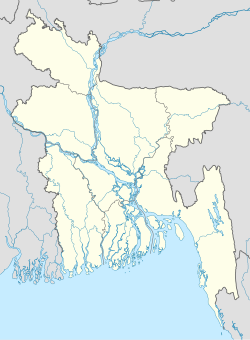Naogaon
|
Naogaon নওগাঁ |
|
|---|---|
| Municipality | |

Clockwise from top: Naogaon K.D. Government High School, Bijoy Monument, Gaza Society office, Shadhinota Monument and Balihar Royal Palace.
|
|
| Location in Bangladesh | |
| Coordinates: 24°48′N 88°56′E / 24.800°N 88.933°E | |
| Country |
|
| Division | Rajshahi Division |
| District | Naogaon District |
| Granted municipality status | 1963 |
| Government | |
| • Type | Municipal government |
| • Mayor | Nazmul Haque Sony |
| Area | |
| • Total | 38.36 km2 (14.81 sq mi) |
| Elevation | 20 m (66 ft) |
| Population | |
| • Total | 150,025 |
| • Literacy rate | 62.% |
| Time zone | Bangladesh Time (UTC+6) |
| Postal code | 6500 |
| Calling code | 0741 |
| Website | naogaonpourashava |
Naogaon (Bengali: নওগাঁ Nôogã) is a town in northern Bangladesh. It is located in the bank of Mini Jamuna river. It is the centre of commerce within the Naogaon District. The area of the town is about 38.36 km2 (14.81 sq mi) and the population is about 150,025. The municipality consists of 9 wards and 56 mahallas.
Naogaon subdivision, under Rajshahi zila, was established in 1877 and was turned into a zila in 1984. The zila consists of 11 upazilas, 99 unions, 2565 mauzas, 2854 villages, 3 paurashavas, 27 wards and 76 mahallas. The upazilas are NAOGAON SADAR, ATRAI, BADALGACHHI, DHAMOIRHAT, MANDA, MAHADEBPUR, NIAMATPUR, Patnitala Upazila, PORSHA, RANINAGAR and SAPAHAR. Background, Geographic Area and Location: Naogaon was one of the sub-divisions of former Rajshahi zila. It was upgraded to zila on the 1st March, 1984. It is believed that the present zila headquarters initially developed in a mauza comprising nine (meaning ‘Nao’ in Bengali) villages (meaning ‘Gaon’ in Bengali). The zila might have derived its name as Naogaon from the words ‘Nao’ and ‘Gaon’. The zila is bounded on the north by India, on the east by Joypurhat and Bogra zilas, on the south by Natore and Rajshahi zilas and on the west by Nawabganj and India. The total area of the zila is 3435.65 km2. (1326.00 sq.miles) of which 9.09 km2. (3.51 sq. miles) is riverine and 19.45 km2 (7.51 sq. miles) is under forest. The zila lies between 24° 32′ and 25° 13′ north latitudes and between 28° 23′ and 89° 10′ east longitudes.
Maximum 37.8 °C and minimum 11.2 °C; annual rainfall 1862 mm.
ATRAI, PUNARBHABA, LITTLE JAMUNA, NAGAR, Chiri and Tulsi Ganga. Guta, Mansur and Dighali beels are notable.
Somapura Mahavihara, Jagaddal Vihara, Halud Vihara, Agrapuri Vihara.
Indigo rebellion (1859–62); peasant revolt against the zamindar in protest of increasing land revenue (1883).
Mass grave 9; mass killing site 7, memorial sculpture 1, monument 1.
Mainly Santal, Oraon and Mahali.
Paddy, potato, watermelon, oil seeds, pulses. Extinct or nearly extinct crops Opium, indigo, aman and aus paddy, tobacco, vetch, cannabis.
Mango, jackfruit, banana, litchi, coconut.
Palanquin, horse carriage, bullock cart, buffalo cart. These means of transport are either extinct or nearly extinct.
...
Wikipedia

